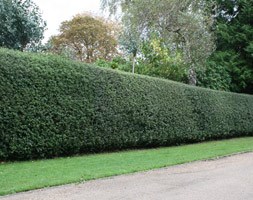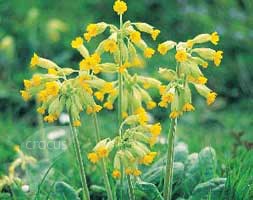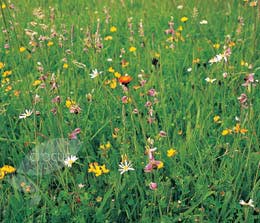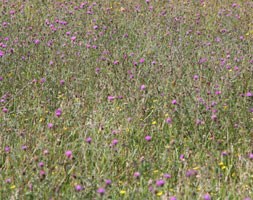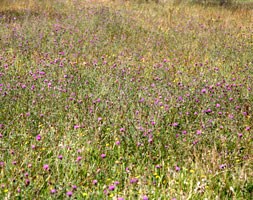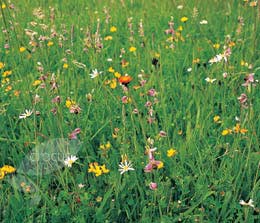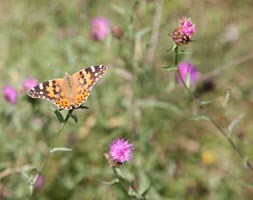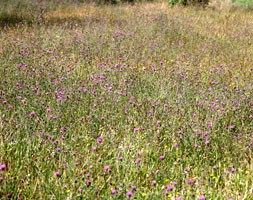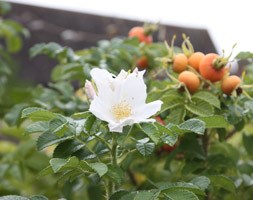New products at Crocus
by Sarah - December 25th, 2014.Filed under: Crocus, New Products.
Crocus has these new lines today
Ilex aquifolium (English holly – Hedging Range) £119.99
Position: full sun or partial shade Soil: moist, well-drained, moderately fertile, humus-rich soil Rate of growth: slow-growing Flowering period: May and June Flower colour: white Other features: the berries may cause a mild stomach upset if ingested; to guarantee berries it’s necessary to plant a male holly nearby; stems of holly are ideal for floral arrangements Hardiness: fully hardy The Royal Horticultural Society bare root hedging range is a very low cost way of planting a hedge. These plants are only available to buy and plant when dormant. (November-March) These plants, with known seed provenence, are grown in 220 acres of rich Herefordshire soil. As they are dispatched directly from the fields, rather than through a nursery, they are much fresher than imported or even stored plants. RHS bare root plants are grown through low input horticultural methods. Plants are rotated with pigs annually, to improve soil condition. Water is harvested in the winter for use in the summer. No heat or polytunnels are used and, as the plants are dispatched direct from the fields, transport is kept to a minimum. To find out more about how to plant a hedge , click here Lustrous, spiny, dark green leaves and long-lasting, bright red berries from autumn to winter. In time this English holly forms a tall conical tree – making a majestic, evergreen specimen plant for large gardens or parks. By far the commonest native tree, it will thrive in any moderately fertile, well- drained soil in sun or partial shade. Garden care: Plants grown as free-standing specimens require minimal pruning – remove diseased or misplaced branches in spring. Trim plants grown as formal hedges in late summer. After pruning apply a generous 5-7cm (2-3in) mulch of well-rotted compost or manure around the base of the plant. Unfortunately we cannot guarantee the sex of our plants. Please note that as we grow the hedging especially for you, we need to take full payment when you place your order so as to reserve stock for you. The bareroot plants will then be despatched to you during November.
Wildflowers for attracting bumble bees (wildflower plug plant collection) £89.99
This wonderful collection of 13 varieties of wild plug plants is perfect for attracting bumble bees. By encouraging bumble bees in to your garden they will return the favour by pollinating your flowers, fruit and vegetables giving you an excellent set on your blossom. They are natures most industrious and harmless workers, never swarming and most don’t have stings either. The plugs will arrive in a tray of 104 plants and cover an area of approximately 21m², planting 5 plants per 1m². The plugs are young plants, not seedlings, and cost just over 64 pence each. Each individual plug’s root volume is approximately 55cc, with a diameter of 36mm and a depth of 60mm. The top growth will depend on the variety and the time of year. Below is what you can expect in your collection, depending on availability. Rock rose, Helianthemum nummularium – 15cm tall with bright yellow flowers Cowslip, Primula veris – 10-15cm bunches of yellow flowers in May-June Betony, Stachys officinalis – 30cm tall with magenta flowers Foxglove, Digitalis purpurea – 100-200cm tall with spires of purple red blooms Birdsfoot trefoil, Lotus corniculatus – 15-30cm tall with yellow, pea-like flowers Clustered bellflower, Campanula glomerata – 15-30cm tall with purple flowers in late summer Blue fleabane, Erigeron acer – 30-40cm tall biennial/perennial, with blue and yellow flowers Harebell, Campanula rotundifolia – 15-30cm tall with dainty blue flowers Hedgerow cranesbill, Geranium pyrenaicum – 25-60cm tall perennial with magenta summer flowers Marjoram, Origanum vulgare – 30cm tall with pink flowers above rosettes of aromatic leaves Red clover, Trifolium pratense – 20-40cm tall with red, nectar-rich flowers White clover, Trifolium repens – 10-15cm creeping perennial with white flowers, often with a hint of pink Wood forget-me-not, Myosotis sylvatica – 30-50cm tall hairy perennial of woods with bright blue flowers Garden care: Your plug plants should be planted out as soon as they arrive. Planting Plugs into Bare Soil: Wildflowers thrive in soils which have a low nutrient content, so it is best to avoid using fertilisers for at least one year before you plant. The area should also be clear of perennial weeds. As a general rule, you should allow 5 plugs to a square metre. Try to plant them randomly, putting 3 of the same species together if you can. The shorter or smaller species e.g. cowslip or centaury look b
Wildflowers for a sunny meadow (wildflower plug plant collection) £89.99
This wonderful collection of 13 varieties of wild plug plants for sunny areas will arrive in a tray of 104 plants. This will cover an area of approximately 21m², planting 5 plants per 1m². The plugs are young plants, not seedlings, and cost just over 64 pence each. Each individual plug’s root volume is approximately 55cc, with a diameter of 36mm and a depth of 60mm. The top growth will depend on the variety and the time of year. Below is what you can expect in your collection, depending on availability. Yarrow, Achillea millefolium – 15-40cm tall with white/pink flowers Agrimony, Agrimonia eupatoria – 30-60cm tall with yellow flowerspikes Lesser knapweed, Centaurea nigra – 40-60cm tall with mauve thistle flowers Greater knapweed, Centaurea scabiosa – 60-100cm tall with purple flowers Centaury, Centaurium erythraea – 15-20cm tall with pink flowers Basil, Clinopodium vulgare – 25-35cm tall with rosy-pink flowers all summer Red valerian, Centranthus ruber – 45cm tall with fragrant red flowers Dropwort, Filipendula vulgaris – 30-45cm tall with cream and pink flowers Lady’s bedstraw, Galium verum – groundcover with tiny yellow flowers Meadow cranesbill, Geranium pratense – 30-45cm tall with bright blue flowers Rock rose, Helianthemum nummularium – 15cm tall with bright yellow flowers Perforate St.John’s wort, Hypericum perforatum – 30-45cm tall with yellow blooms Common catsear, Hypochaeris radicata – 15-30cm tall with yellow flowers Field scabious, Knautia arvensis – 30-60cm tall with pale blue flowers Meadow vetchling, Lathyrus pratensis – 30-45cm tall with yellow flowers Oxeye daisy, Leucanthemum vulgare – 30-45cm white ‘moon’ daisy Bird’s foot trefoil, Lotus corniculatus – 15-30cm tall with yellow flowers Musk mallow, Malva moschata – 30-45cm tall with delicate pink flowers Marjoram, Origanum vulgare – 30cm tall with pink flowers in August Jacob’s ladder, Polemonium caeruleum – 30-90cm tall with dark purple flowers Ribwort plantain, Plantago lanceolata – 15-30cm with brownish flowers Cowslip, Primula veris – 10-15cm bunches of yellow flowers in May-June Selfheal, Prunella vulgaris – 10-30cm tall with red-purple blooms in May-June Meadow buttercup, Ranunculus acris – 40-100cm tall perennial with lemon-yellow flowers Sorrel, Rumex acetosa – 60-100cm erect perenial flowering in May-June Wild clary, Salvia verbenaca – 30-40cm tall with violet-blu
Wildflowers for a stronger colour sunny meadow display (wildflower plug plant collection) £89.99
This stronger colour selection of wildflower plugs for a sunny meadow is made up of 13 varieties, with blues, reds and yellows being the main colours, and will arrive in a tray of 104 plants. This will cover an area of approximately 21m², planting 5 plants per 1m². The plugs are young plants, not seedlings, and cost just over 64 pence each. Each individual plug’s root volume is approximately 55cc, with a diameter of 36mm and a depth of 60mm. The top growth will depend on the variety and the time of year. Below is what you can expect in your collection, depending on availability. Fox & cubs, Pilosella aurantiaca – bright orange flowers from June to August Ragged robin, Lychnis flos-cuculi – 30cm tall perennial with bright pink ragged flowers Yellow toadflax, Linaria vulgaris – yellow/orange spikes of snapdragon-like flowers in July Lesser knapweed, Centaurea nigra – 40-60cm tall with mauve thistle flowers Devil’s bit scabious, Succisa pratensis – lavender blue flowers in late summer Betony, Stachys officinalis – deep magenta flowers in June Giant bellflower, Campanula latifolia – grows to 1m tall with blue blooms in summer Red campion, Silene dioica – 30-45cm tall with pink-red blooms Cowslip, Primula veris – 10-15cm bunches of yellow flowers in May-June Meadow cranesbill, Geranium pratense – 30-45cm tall with bright blue flowers Bloody cranesbill, Geranium sanguineum – 20-30cm tall perennial with magenta flowers Maiden pink, Dianthus deltoides – 10-20cm tall perennial herb with dark rose-pink flowers Vipers bugloss, Echium vulgare – 30-100cm tall with blue flowers in June Hawkweed, Hieracium agg. – grows 30-40cm tall with bright ‘dandelion’ type flowers Heartsease, Viola tricolor – short lived perennial with purple flowers often blotched with yellow Sainfion, Onobrychis viciifolia – bright pink racemes of flowers from July to August Elecampane, Inula helenium – bright yellow sunflower-like daisies in summer Jacobs ladder, Polemonium caeruleum – 30-90cm tall with dark purple flowers Yellow horned poppy, Glaucium flavum – 30-45cm grey perennial with clear yellow flowers Wild clary, Salvia verbenaca – 30-40cm tall with violet-blue flowers Great burnet, Sanguisorba officinalis – 30-60 cm tall perennial with raspberry-like flowers Golden rod, Solidago virgaurea – bright yellow flowers from June to September Tansy, Tanacetum vulgare – 30-100cm tall perenn
Wildflowers for a boggy meadow (wildflower plug plant collection) £89.99
This wonderful collection of 13 varieties of wild plug plants for wet areas will arrive in a tray of 104 plants. This will cover an area of approximately 21m², planting 5 plants per 1m². The plugs are young plants, not seedlings, and cost just over 64 pence each. Each individual plug’s root volume is approximately 55cc, with a diameter of 36mm and a depth of 60mm. The top growth will depend on the variety and the time of year. Below is what you can expect in your collection, depending on availability. Sneezewort, Achillea ptarmica – 30-60cm tall with white flowers Meadowsweet, Filipendula ulmaria – 60-100cm tall with cream flowers Water avens, Geum rivale – 20-30cm tall with peach-red blooms Yellow flag iris, Iris pseudacorus – 40-200cm tall stately iris Ragged robin, Lychnis flos-cuculi – 30-45cm tall with bright pink ragged flowers Purple loosetrife, Lythrum salicaria – 45-60cm tall with rosy- magenta flower spires Meadow buttercup, Ranunculus acris – 40-100cm tall perennial with lemon-yellow flowers Lady’s smock, Cardamine pratensis – 15-30cm tall with pink, spring blooms Greater bird’s foot trefoil, Lotus uliginosus – 30cm tall perennial with yellow flowers Marsh marigold, Caltha palustris – 30-45cm tall with bright yellow, buttercup-like blooms Lesser spearwort, Ranunculus flammula – 30-50cm creeping perennial with pale yellow flowers Watercress, Rorippa nasturtium aquaticum – spreading perennial with white flowers Celery-leaved buttercup, Ranunculus scleratus – 45-60cm tall annual with small yellow flowers Gipsywort, Lycopus europaeus – 30-100cm tall Hemp agrimony, Eupatorium cannabinum – 45-60cm tall with pink flowers Water mint, Mentha aquatica – 30-40cm tall with pink flowers Garden care: Your plug plants should be planted out as soon as they arrive. Planting Plugs into Bare Soil: Wildflowers thrive in soils which have a low nutrient content, so it is best to avoid using fertilisers for at least one year before you plant. The area should also be clear of perennial weeds. As a general rule, you should allow 5 plugs to a square metre. Try to plant them randomly, putting 3 of the same species together if you can. The shorter or smaller species e.g. cowslip or centaury look best in clumps of 5, the taller ones like knapweeds or ox-eye daisies look best in groups of 2 or 3 to a square metre. If you want more immediate colour, you can put your plugs in, and th
Wildflowers for a shady meadow (wildflower plug plant collection) £89.99
This wonderful collection of 13 varieties of wild plug plants for shady areas will arrive in a tray of 104 plants. This will cover an area of approximately 21m², planting 5 plants per 1m². The plugs are young plants, not seedlings, and cost just over 64 pence each. Each individual plug’s root volume is approximately 55cc, with a diameter of 36mm and a depth of 60mm. The top growth will depend on the variety and the time of year. Below is what you can expect in your collection, depending on availability. Wild strawberry, Fragaria vesca – 10-15cm spreading perennial with white flowers Hedge bedstraw, Galium mollugo – trailing with minute white flowers Hedgerow cransbill, Geranium pyrenaicum – 25-60cm tall with magenta blooms Lesser celandine, Ranunculus ficaria – 10cm tall with bright yellow buttercup flowers Betony, Stachys officinalis – 30cm tall with magenta flowers Dog violet, Viola riviniana – 20cm tall with blue-purple blooms Nettle-leaved bellflower, Campanula trachelium – 30-45cm tall with dark blue flowers Foxglove, Digitalis purpurea – 100-200cm tall with spires of purple red blooms Primrose, Primula vulgaris – the herald of spring! Selfheal, Prunella vulgaris – 10-30cm tall with red-purple blooms in May-June Red campion, Silene dioica – 30-45cm tall with pink-red blooms Greater stitchwort, Stellaria holostea – scrambling, slender stems and star-like flowers Tufted vetch, Vicia cracca – clambering perennial with blue-violet flowers Oxeye daisy, Leucanthemum vulgare – 30-45cm white ‘moon’ daisy Great burnet saxifrage, Pimpinella major – 50-100cm tall with umbels of pinkish-white flowers Wood avens, Geum urbanum – 30cm tall with yellow flowers in May Oxlip, Primula elatior – 15-20cm tall with pale yellow flowers Wood sage, Teucrium scorodonia – 30cm tall with greenish- yellow blooms Meadowsweet, Filipendula ulmaria – 60-100cm tall with cream flowers Wood cranesbill, Geranium sylvaticum – 30-60cm with purple- magenta flowers Figwort, Scrophularia nodosa – 30-60cm tall with tiny maroon and green flowers Garden care: Your plug plants should be planted out as soon as they arrive. Planting Plugs into Bare Soil: Wildflowers thrive in soils which have a low nutrient content, so it is best to avoid using fertilisers for at least one year before you plant. The area should also be clear of perennial weeds. As a general rule, you should allow 5 plugs to a square metre
Wildflowers for attracting butterflies (wildflower plug plant collection) £89.99
This collection of wildflower plugs provides nectar and larval food for butterflies and is made up of 13 varieties that will arrive in a tray of 104 plants. This will cover an area of approximately 21m², planting 5 plants per 1m². The plugs are young plants, not seedlings, and cost just over 64 pence each. Each individual plug’s root volume is approximately 55cc, with a diameter of 36mm and a depth of 60mm. The top growth will depend on the variety and the time of year. Below is what you can expect in your collection, depending on availability. Kidney vetch, Anthyllis vulneraria – long stems of wholly yellow flowers which provide food for the Blue butterfly and Six Belted Clearwing moth Fennel, Foeniculum vulgare – feathery leaves are strongly pungent and yellow flowers which are rich in nectar Evening primrose, Oenothera biennis – 60-100cm tall with yellow flowers which are a food source for the Elephant Hawk moth Greater mullien, Verbascum thapsus – lovely yellow flowers in summer and is food plant for Mullein moth Bird’s foot trefoil, Lotus corniculatus – spreading perennial with yellow pea-like flowers, a good food plant for Common Blue, Clouded Yellow Wood White, Green Hairstreak and Dingy Skipper butterflies plus Six Spot Burnet, Chalk Carpet and Straw Belle moths Yarrow, Achillea millefolium – 15-40cm tall with white, sometimes pink, flowers, a good food plant for Lime Speck Pug, Wormwood Pug Straw Belle and Tiger moths Lesser knapweed, Centaurea nigra – 40-60cm tall perennial with mauve thistle-like flowers, excellent for nectar for migrant butterflies Red valerian, Centranthus ruber – 45cm tall with fragrant red flowers in summer and much loved by butterfies Teasel, Dipsacus fullonum – 45-200cm stately perennial with flowers rich in nectar and attractive by all bee species Wild carrot, Daucus carota – 30-100cm tall biennial with white flowers which are nectar rich and attractive to hoverflies Vipers bugloss, Echium vulgare – 30-100cm tall with blue flowers in June, a favourite nectar source for the Painted Lady butterfly Ladys bedstraw, Galium verum – low growing, spreading perennial and yellow flowers food for Humming Hawk and Elephant Hawk moths Autumn hawkbit, Leontodon autumnalis – 15-30cm tall with bright yellow dandelion-like flowers, a good late nectar plant Cowslip, Primula veris – 10-15cm bunches of yellow bells in May and June which are food source for the F
Grasses for a wildflower meadow (wild grass plug plant collection) £89.99
This wonderful collection of 13 varieties of wild grass plug plants will arrive in a tray of 104 plants. This will cover an area of approximately 21m², planting 5 plants per 1m². The plugs are young plants, not seedlings, and cost just over 64 pence each. Each individual plug’s root volume is approximately 55ccs, with a diameter of 36mm and a depth of 60mm. The top growth will depend on the variety and the time of year. Below is what you can expect in your collection, depending on availability. Meadow Foxtail, Alopecurus pratensis – 60-120cm tall Marram Grass, Ammophila arenaria – rhizomatous perennial Sweet Vernal Grass, Anthoxanthum odoratum – yellow-green grass 30-45cm tall Quaking Grass, Briza media – 30cm tall with quaking seedheads all summer Green-ribbed Sage, Carex binervis – creeping perennial that flowers in May-June White Sedge, Carex curta – 50cm tall at flowering Starved Wood Sedge, Carex depauperata – 30-100cm tall flowering stems and yellow-green leaves Glaucous Sedge, Carex flacca – 10-40cm tall creeping sedge Carnation Sedge, Carex panicea – 10-40cm tall with brown- purple flowers Pendulous Sedge, Carex pendula – 100-150cm tall with cat’s tail like flowers Flea Sedge Cyperus Sedge, Carex pseudocyperus – 90-100cm tall perennial sedge Wood Sedge, Carex sylvatica – bright green perennial with 45cm flowerspikes Long Stalked Yellow Sedge, Carex viridula – bright yellow- green leaves and lighter yellow flowers Crested Dog’s Tail, Cynosurus cristatus – 75cm tall tufted perennial Tufted Hair Grass, Deschampsia cespitosa – 150-200cm tall at flowering Sea Couch, Elytrigia atherica – 100cm tall with glaucous leaves Tall Fescue, Festuca arundinacea – 120-200cm tall with 45cm long flower panicles Sheep’s Fescue, Festuca ovina – 25cm tall with slightly glaucous leaves Red Fescue, Festuca rubra – 75-100cm tall flowering in June to August Meadow Oat Grass, Helictotrichon pratense – tufted grass 80cm tall when flowering Jointed Rush, Juncus articulatus – 20-80cm erect or spreading grass with glossy green leaves Bulbous Rush, Juncus bulbosus – remains green all year and produces brown flowers May-August Soft Rush, Juncus effusus – 60-120cm tall densely tufted perennial Field Woodrush, Luzula campestris – 10-20cm tall flowering rush Southern Woodrush, Luzula fosteri – tufted perennial with brown-green flowers Woodrush, Luzula sylvatica – 30-40cm large tussocks of
Rosa rugosa ‘Alba’ (rose (shrub) – Hedging range) £54.99
Position: full sun Soil: fertile, humus-rich, moist, well-drained soil Rate of growth: fast-growing Flowering period: July to September Flower colour: white Other features: excellent cut-flowers Hardiness: fully hardy The Royal Horticultural Society bare root hedging range is a very low cost way of planting a hedge. The bare root plants are only available to buy and plant when dormant. (November-March) These plants, with known seed provenence, are grown in 220 acres of rich Herefordshire soil. As they are dispatched directly from the fields, rather than through a nursery, they are much fresher than imported or even stored plants. RHS bare root plants are grown through low input horticultural methods. Plants are rotated with pigs annually, to improve soil condition. Water is harvested in the winter for use in the summer. No heat or polytunnels are used and, as the plants are dispatched direct from the fields, transport is kept to a minimum. To find out more about how to plant a hedge , click here Masses of fragrant, single, yellow-centred, white flowers from July to September, followed by large, red or orange-red rose-hips. This vigorous, white species rose makes a great, informal, flowering hedge for an open, sunny site. An excellent choice for the wildlife garden, the leathery, dark-green leaves turn butter-gold in autumn. Please note that as we grow the hedging especially for you, we need to take full payment when you place your order so as to reserve stock for you. The bareroot plants will then be despatched to you during November. All our roses are grown in an open field and then dug up when the weather conditions are right in October or November. Ideally they should be planted out as soon as possible. They will already have been cut back so no further pruning will be required, apart from snipping off any tips that have died back. Routine pruning can begin in late winter the year after planting. Garden care: If planting in winter, choose a frost-free spell when the soil is not frozen. Roses are quite deep-rooted plants so dig a deep hole roughly twice as wide as the plants roots and mix in a generous amount of composted organic matter. A top-dressing of a general purpose fertiliser can be worked into the surrounding soil and we also recommend using Rose Rootgrow at this stage to encourage better root development. This is particularly important when planting into a bed where roses ha







